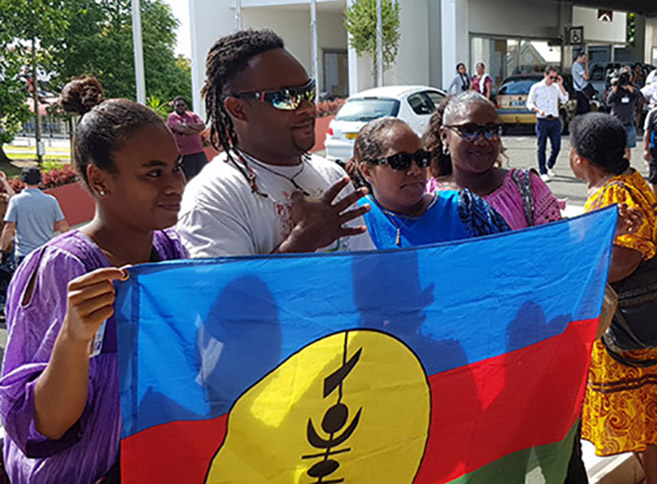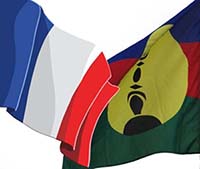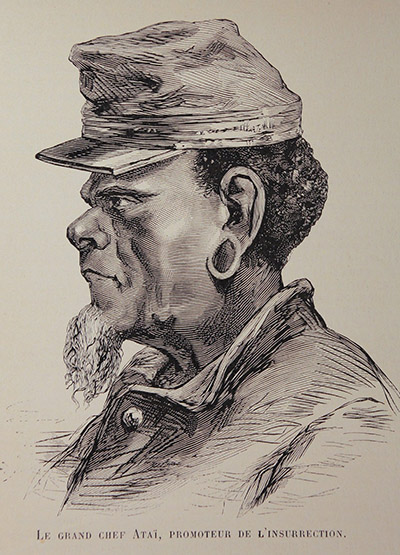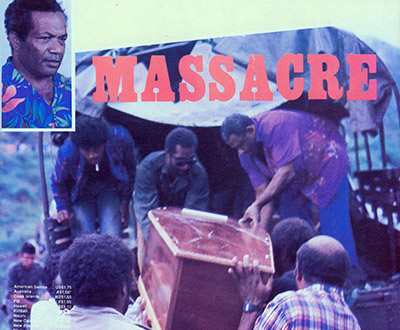
Key dates in New Caledonia’s colonial history:
1774: James Cook “discovers” Grande Terre island for Europe and renames it New Caledonia because the landscapes remind him of Scotland.

1853: Admiral Febvrier-Despointes plants the French tricolour at Balade on the east coast of Grande Terre, and takes possession of the island for Emperor Napoleon III to establish a penal colony.
1864: France despatches some 21,630 prisoners between 1864 and 1897. The convicts include 4250 “communard” revolutionaries from Paris.
1874: Exploitation of the nickel reserves begins after being discovered by engineer Jules Garnier a decade earlier.

1878: Grand Chief Ataï leads the first Kanak rebellion against colonisation, with a death toll of about 1200 Kanaks and 200 Europeans. Chief Ataï is beheaded and his skull is sent to the Anthropology Society in Paris for further study.
1917: When the First World War breaks out in Europe, the colonial administration tries to pressure Kanaks into enlisting (they are not yet full citizens of the republic). Following another revolt, three Kanak leaders are guillotined.
1931: Authorities take 111 Kanaks to a colonial exhibition in Paris as “authentic cannibals”. The same year the penal colony is finally closed.
1946: The Kanaks, deprived of rights under the Code Indigénat since 1887, which makeas all French-governed indigenous peoples second class citizens, gain full citizenship.

1984: The FLNKS (Front de libération nationale kanak et socialiste) is created and organises a Kanak boycott of the territorial elections. The islands are on the edge of insurrection. On December 5, near Hienghène, 10 unarmed Kanak activists are assassinated in an ambush by mixed-race Caldoche (settlers).
1987: On September 13, the people of New Caledonia vote in a referendum on independence that is boycotted by the FLNKS and other pro-independence groups. The vote against independence is 98.3 percent with just 1.7 percent voting yes.
1988: On Ouvéa island, 4 gendarmes are killed by FLNKS militants during the kidnap of a local police garrison. On May 5, French security forces storm the Gossanah cave where 27 gendarmes are being held hostage. Nineteen Kanaks and two soldiers are killed. On June 26, the Matignon Accord is signed by Jean-Marie Tjibaou, president of the FLNKS; Jacques Lafleur, leader of the anti-independence Rassemblement pour la Caledonie dans la republique (RPCR); and Prime Minister Michel Rocard. The accord envisages self-determination in 10 years.
1989: On May 4, Jean-Marie Tjibaou and Yeiwéne Yeiwéne, his FLNKS deputy, are assassinated on Ouvea by Djubelly Wéa, a Kanak indépendantiste opposed to the Matignon Accord.
1998: The Nouméa Accord is signed by French prime Minister Lionel Jospin, Jacques Lafleur and Roch Wamytan, the new president of the FLNKS. This accord envisages progressive “emancipation” for New Caledonia. A referendum shows 72 percent in favour of the accord.
2004: Bittedrly divided for 15 years, the Tjibaou, Yeiwéne and Wéa families meet at the Tjibaou tribu village of Tiendanite for a custom “forgiveness” ceremony.
2010: Prime Minister François Fillon makes official the flying of both the French and Kanak flags on official buildings and at events. Jacques Lafleur dies on December 4.
2014: The Museum of Natural History in Paris returns the skull of Chief Ataï to his descendants, 136 years after the death of the revolutionary chief.
2018: On November 4, the eligible voters of New Caledonia vote on independence with 56.4 percent rejecting independence and 43.6 percent voting in favour. Up to two further votes on independence are provided for in the Nouméa Accord for 2020 and 2022.
2020: And next …?
Source: Translated and adapted from Geo, September 2018
- New Caledonia votes to stay with France, but independence supporters take heart
- New Caledonia’s independence referendum and how it could impact on the region










































